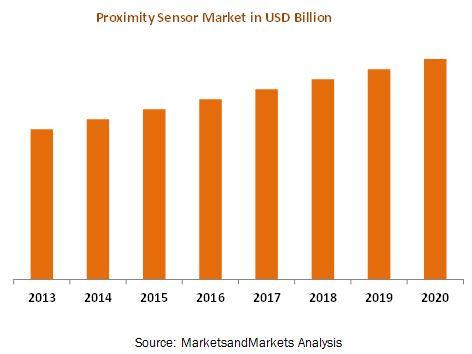Increase in automation of complex production systems has led to the demand for components that are capable of providing important data regarding the production process. Proximity sensors facilitate process control in factories by detecting the presence and accurate positioning of metal objects. Proximity sensors help in automating procedures and even repetitive tasks resulting in efficient production line. Since proximity sensors can operate at a higher speed than traditional switches, they are preferred for automation. Proximity sensors with features such as environment resistance, heat resistance, resistance to chemicals, and resistance to water are in demand for industrial automation.
Touch free user interface is attracting the market for proximity sensors in automotive applications. Applications where proximity sensors can be used in automotive include infotainment system, 3D gesture, keyless entry system, and interior lighting control. Under parking assistance system, proximity sensors detect the presence of objects in the pathway of the reversing vehicle and raise an alarm to warn the driver. Proximity sensors also help prevent collision with pedestrians while parking.
Proximity sensor’s non-contact sensing technology, long-distance sensing, high accuracy, increased repeatability, small part detection, and sensing in hazardous environment are some of the attributes which are likely to fuel the growth of the proximity sensor market in the coming years.
The key players in the market include Avago Technologies Inc. (Singapore), IFM Electronic GmbH (Germany), Schneider Electric (France), Panasonic Corporation (Japan), Balluff GmbH. (Germany.), Hans Turck GmbH & CO., KG. (Germany), Pepperl + Fuchs GmbH (Germany), Rockwell Automation (U.S.), Omron Corporation (Japan), Honeywell International Inc. (U.S.), Fargo Controls (U.S.), and Sick AG ( Germany).
Speak to Analyst @ Click Here
The report predicts that the proximity sensor market in 2020 would be USD 3.7 billion, growing at a compound annual growth rate (CAGR) of 5.3% between 2015 and 2020.
The report provides the market size and forecast of proximity sensor market with broader segmentation—by type, sensing distance, technology, industry and geography. The industry segment covers aerospace & defense, automotive, food & beverage, pharmaceuticals, consumer electronics, building automation, industrial manufacturing.
The report also provides an in-depth analysis of the key players in the proximity sensor products and services ecosystem with their profiles, recent developments, key issues, SWOT analysis and opportunities in the market, global adoption trends, and future growth potentials.



